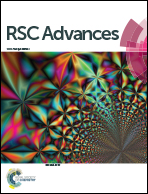Assembly of polyoxometalates and Ni-bpy cationic units into the molecular core–shell structures as bifunctional electrocatalysts†
Abstract
Four polyoxometalate-based supramolecular assemblies were designed and synthesized under hydrothermal conditions: [Ni(2,2-bpy)3]5[PW11NiO39(H2O)]2·1.08H2O (1), [Ni(2,2-bpy)3]1.5[Ni(2,2-bpy)2(H2O)BW12O40] (2), {[Ni(2,2-bpy)3]1.5[Ni(2,2-bpy)2(H2O)GeW12O40]}− (3), and {[Ni(2,2-bpy)3]1.5[Ni(2,2-bpy)2(H2O)PW12O40]}2− (4). These structures were characterized by IR, TG analysis, elemental analysis, X-ray powder diffraction and single-crystal X-ray diffraction. In compound 1, two mono-substituted [PW11NiO39(H2O)]5− anions were fused together via the H-bonding interactions forming a dimeric polyoxoanion [PW11NiO39(H2O)]210−, which was surrounded by Ni-bpy cationic units into the molecular core–shell structures. Compounds 2–4 were composed of saturated polyoxoanions [BW12O40]5−, [GeW12O40]4− and [PW12O40]3−, respectively. These saturated anions were surrounded by [Ni(2,2-bpy)3]2+ and [Ni(2,2-bpy)2(H2O)]2+ cationic units forming isostructural core–shell organic–inorganic hybrid materials. These isostructural polyoxometalates with different heteroatoms and charges all formed the isostructural materials, indicating that their charges do not have a significant influence on the structure of supramolecular assemblies. A detail study showed that substituted polyoxometalate with the terminal H2O molecule is essential for constructing the larger core–shell structure. An electrocatalytic study indicated that these four compounds are bifunctional electrocatalysts towards water oxidation and reduction of nitrite.


 Please wait while we load your content...
Please wait while we load your content...